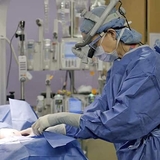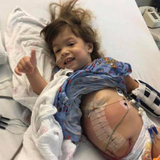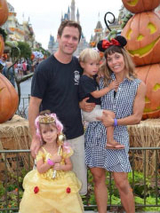Giant Omphalocele: Emma’s Story
Giant Omphalocele: Emma’s Story
Emma’s mom may hold a world record for burpees, a full-body athletic movement, but Emma is a champion in her own right. The sweet 6-year-old is hailed as a medical “trailblazer” by one of her surgeons at Children’s Hospital of Philadelphia. Emma survived a rare birth defect that causes infants to be born with abdominal organs outside their body.
“She beat all the odds,” Gena says of her daughter, a strong, thriving kindergartner who loves to emulate her athletic mom.
A frightening diagnosis

Looking back, Gena, a former nurse who now co-owns a gym, was surprised but excited when she found out she was pregnant with her first child. But nothing, not even her own nursing training, could have prepared her for her 13-week ultrasound, where she learned that some of her baby’s organs were growing outside of the abdomen, a condition known as giant omphalocele.
When Gena and her husband, Ron, a firefighter, heard the news, they were scared and confused. Most of all, they were determined to give their baby every possible chance to live a healthy life.
Giant omphalocele occurs when a defect in the abdominal wall allows the majority of the liver and intestines to remain outside the baby’s body while the umbilical cord forms a sac around them. As a result, the chest cavity is often narrowed, leading to small lungs or pulmonary hypoplasia. Babies often have difficult eating and gaining weight. While the cause for the defect is largely unknown, left untreated it can be life-threatening
Finding experts in omphalocele
Looking for the best possible care for their baby, online research led the parents to make an appointment at Children’s Hospital of Philadelphia (CHOP), an hour’s drive away from their New Jersey home.
Gena was 17 weeks into her pregnancy when she underwent a daylong series of advanced prenatal imaging tests at CHOP’s Center for Fetal Diagnosis and Treatment (CFDT), the most experienced fetal treatment center in the world, where a multidisciplinary team of clinicians treat more than 30 cases of omphalocele each year. But the results of Gena’s tests were not what the couple had hoped to hear.
“They told us this was one of the worst cases of omphalocele ever seen at CHOP. They told us to expect the worst, but hope for the best,” recalls Gena. Emma’s fate was so fragile the couple was introduced to CHOP’s perinatal palliative care team for additional support.
Though it wasn’t easy when doctors put her on bed rest at 20 weeks gestation, Gena knew it was for the best. As the center monitored her pregnancy, Gena also kept in touch with her OB-GYN closer to home, Edward L. Sung, MD.
‘The most beautiful baby’
Emma was born by C-section, in the CFDT’s Garbose Family Special Delivery Unit (SDU), nearly seven weeks before her due date. She weighed 4 pounds and 12 ounces.
“Emma, it’s mommy. You are so strong. You can do this,” Gena recalls saying to cheer her daughter on as she was being stabilized by a team of pediatric surgeons, neonatologists, nurses and respiratory therapists, all with extensive experience in treating babies with omphalocele.

Neonatal surgical team
The Neonatal Surgical Team cares for babies who need surgery or other complex care immediately or soon after birth.
Later that afternoon, Gena visited Emma for the first time in CHOP’s Newborn/Infant Intensive Care Unit (N/IICU), which is located near the SDU. She could only touch her tiny daughter through holes in the incubator.
“She was the most beautiful baby I ever saw, and she had the most hair,” recalls Gena. “I remember her gripping my hand. It was just the best.”
There was a thin sac around Emma’s abdominal organs, including her liver, small and large intestines, and stomach. The sac was covered with a sterile dressing, a ventilator helped her breathe, and a feeding tube provided her with all the necessary nutrients to continue to grow.
The plan was to allow the organs to gradually return to the abdominal cavity while allowing the lungs to grow without the immediate pressure of surgical closure. The process is called “paint and wait.” The sac covering her omphalocele was “painted” with an antibiotic cream while the skin gradually grew over the sac.
For nine and a half months, Emma remained in the surgical section of the N/IICU under the care of a specialized, multidisciplinary Neonatal Surgical Team. For the first three months of Emma’s hospital stay, Gena lived at the nearby Ronald McDonald House. For the rest of her stay, Gena made the daily trip from home each day, remaining by her side from “sun up to sun down.” Gena and Ron were encouraged to hold and read to Emma, and to be involved as members of the care team.
Healing omphalocele

As the CHOP team monitored Emma’s progress, Gena and Ron learned how to care for their daughter. Though Emma had nursing care at home, Gena never relinquished what she considered her motherly tasks, like changing Emma’s wound dressings.
Emma, who was fully ventilator-dependent at birth, was 3 months old when a tracheostomy tube was inserted into her neck to help her breathe. The procedure marked the first of six surgeries she would undergo. It also defined the moment Gena felt she could finally be the hands-on mother she wanted to be for her daughter.
At 7 months old, Emma underwent a lengthy surgery to correct a bowel obstruction which interfered with her ability to tolerate feedings.
“They rarely performed this type of surgery with an omphalocele baby so we weren’t sure it was going to work,” says Gena. “It did, and it’s now used on others that have had the same complications. One of the surgeons called Emma a trailblazer.”
Soon after her first birthday, Emma was walking, but still on a feeding tube. All the while, the sac on her abdomen remained wrapped in elastic bandages, which were compressed over time to slowly push her organs back into her abdomen. She was 2 ½ when saline balloons were surgically inserted to help stretch the skin of her abdomen. When enough skin had grown, doctors removed the balloons and used special materials to close the abdominal muscle. They even created a belly button. When Emma was 3 ½ all of her organs were finally back inside her body, and her omphalocele was surgically closed.
Life after omphalocele

Today, Emma, nearly 7, is flourishing despite the early years of uncertainty around her condition, says Gena. Superactive, Emma loves reading Dr. Seuss, watching “Frozen,” and being a big sister to her brother, Owen. Since her feeding tube was removed in 2018, she especially enjoys eating her favorite foods like pizza and PB & J sandwiches.
Every few months, she has follow-up visits through CHOP’s Pulmonary Hypoplasia Program with her nutritionist, Robin Cook, MS, RD, and her pediatric surgeon, Holly Hedrick, MD, as well as pulmonary, gastroenterology and cardiology specialists.
Every January on Omphalocele Awareness Day, Gena tries to give back, to show how grateful her family is to have Emma with them. This year, she did a burpee challenge at her gym, with a percentage of contributions going to CHOP.
“We just love CHOP. They saved Emma’s life multiple times. We are so lucky they are in our backyard.”
For Gena, completing 5,332 burpees in 12 hours was not only exhilarating, but it also landed her in the Guinness Book of World Records. The best part was having Emma join her in the last 10 minutes of the challenge.
“She really is the strongest person I know,” says Gena.
Your gift creates breakthroughs
Philanthropic gifts are vital to making breakthrough stories like this one a reality for sick children. With your help, we can provide innovative care, pioneering treatments and lifesaving cures to children … today, tomorrow and for years to come.